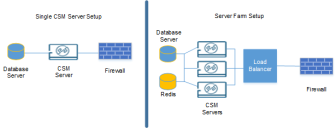Scaling the CSM Web Applications
A Cherwell server farm enables you to scale CSM web applications less expensively and without the constraints of a single server. A server farm allows high volumes of users to utilize several medium (4-core or higher) servers. A server farm typically consists of multiple CSM servers connecting to multiple Redis servers.
There is near-linear growth using Cherwell server farms. The more servers added to the farm, the more users CSM web applications can support. For example, assuming identical hardware is used, if users are consuming 100 percent of CPU on a single server, create a farm with three servers to support more users. If two servers support 100 users, then three servers can support 150 users.
There are two main reasons to implement a Cherwell server farm:
- To scale the number of users.
You can add more hardware and grow horizontally to satisfy the demands of the population. In a single-server scenario, you would have to add hardware to a single server, but there's a limit to the amount of hardware you can implement in a single machine. The more you grow a single server, the more expensive it gets. Use a Cherwell server farm to add low-cost commodity boxes to the farm without having to exponentially pay more.
- To provide redundancy.
A Cherwell server farm eliminates a single point of failure because if one server fails or is taken down for maintenance, CSM can still be used by its users.
Some scaling can typically be done in a single-server scenario just by adding CPUs and memory to the one machine. Such a proposition usually costs more than increasing the number of commodity servers in a Cherwell server farm.
Server Farm Components
Server farms can be configured differently from business to business, but all server farms should have similar components set up in the same way.
A server farm will contain the following components at a minimum:
- Load Balancer (not provided by Cherwell): Takes a certain load of users and balances them out across different servers. The load balancer is set up between the company firewall and the web service servers. The load balancer directs traffic to the server with the most availability, or one of the other distribution methods.
- Web Servers: Deliver information and process users' requests. All servers must be configured the same way. Be sure all servers have the same hardware configuration and point to the same SQL and Redis. There are two types of servers:
- A physical server (box)
- A virtual server, which is a software server, installed on a physical server; or a virtual machine installed on a hypervisor (bare-metal OS installed on a physical host).
- Databases (not provided by Cherwell): The SQL Server and Redis Server hold the content of a CSM system.
